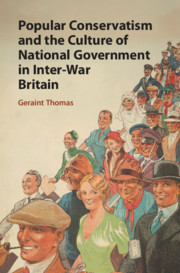Book contents
- Popular Conservatism and the Culture of National Government in Inter-War Britain
- Popular Conservatism and the Culture of National Government in Inter-War Britain
- Copyright page
- Contents
- Figures and Tables
- Acknowledgements
- Abbreviations
- 1 The National Government and Interwar Conservatism: The Historical Task
- Part I Rethinking Interwar Conservatism
- Part II Popular Conservatism and the National Government
- Part III Reputations of Government
- 8 The Unravelling of National Anti-Socialism?
- Conclusion
- Appendix Parties’ Share of the Vote in the Constituency Case-Study Areas, 1918–1945
- Bibliography
- Index
8 - The Unravelling of National Anti-Socialism?
from Part III - Reputations of Government
Published online by Cambridge University Press: 28 November 2020
- Popular Conservatism and the Culture of National Government in Inter-War Britain
- Popular Conservatism and the Culture of National Government in Inter-War Britain
- Copyright page
- Contents
- Figures and Tables
- Acknowledgements
- Abbreviations
- 1 The National Government and Interwar Conservatism: The Historical Task
- Part I Rethinking Interwar Conservatism
- Part II Popular Conservatism and the National Government
- Part III Reputations of Government
- 8 The Unravelling of National Anti-Socialism?
- Conclusion
- Appendix Parties’ Share of the Vote in the Constituency Case-Study Areas, 1918–1945
- Bibliography
- Index
Summary
The National Government entered a new phase in the spring of 1937, as Neville Chamberlain succeeded Stanley Baldwin as Conservative leader and Prime Minister. As this chapter shows, appeasement, though controversial, preserved peace in the present and did little to disrupt the Conservatives’ continuing efforts to construct their popular appeals around the government’s record of economic recovery from 1931. Drawing upon all twelve constituency case studies, the chapter considers the impact of rearmament on employment levels and assesses the local implications of the government’s social reform programme, including the Education Act 1936, the Holiday with Pay Act 1938 and especially the impact of the Physical Training and Recreation Act 1937 on local government facilities. The chapter also demonstrates how Labour wrestled back some control of the political initiative in the late 1930s. It argues that Labour began to restore its own reputation for competent government through a well-publicised programme of municipal social reform in London, its growing presence in neighbourbood organization (including among the suburban electorate), and its critique of the government’s handling of the distressed area. In doing so, Attlee’s party not only contested the government’s narrative of recovery, it also began the process of articulating a particular version of 1930s Britain that ultimately defined Britons’ political and historical imaginary for several generations.
Keywords
- Type
- Chapter
- Information
- Publisher: Cambridge University PressPrint publication year: 2020

